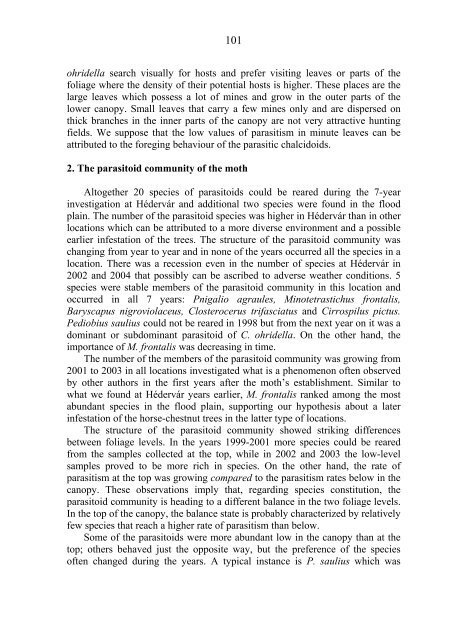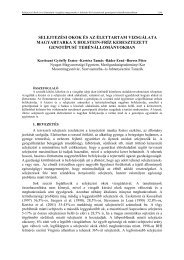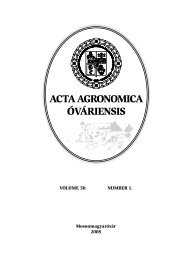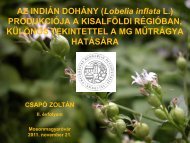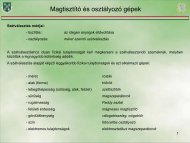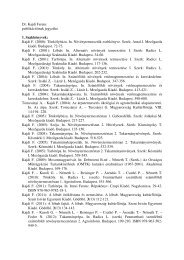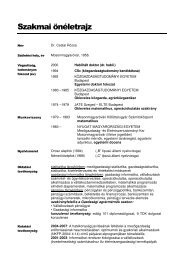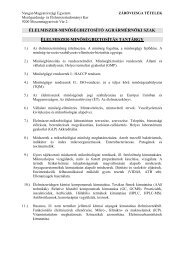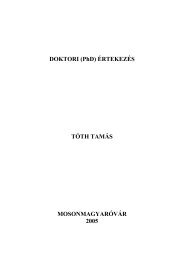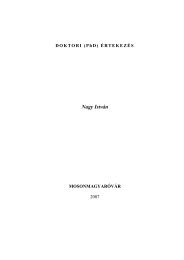DOKTORI (PhD) - Nyugat-Magyarországi Egyetem Mezőgazdaság
DOKTORI (PhD) - Nyugat-Magyarországi Egyetem Mezőgazdaság
DOKTORI (PhD) - Nyugat-Magyarországi Egyetem Mezőgazdaság
You also want an ePaper? Increase the reach of your titles
YUMPU automatically turns print PDFs into web optimized ePapers that Google loves.
101<br />
ohridella search visually for hosts and prefer visiting leaves or parts of the<br />
foliage where the density of their potential hosts is higher. These places are the<br />
large leaves which possess a lot of mines and grow in the outer parts of the<br />
lower canopy. Small leaves that carry a few mines only and are dispersed on<br />
thick branches in the inner parts of the canopy are not very attractive hunting<br />
fields. We suppose that the low values of parasitism in minute leaves can be<br />
attributed to the foreging behaviour of the parasitic chalcidoids.<br />
2. The parasitoid community of the moth<br />
Altogether 20 species of parasitoids could be reared during the 7-year<br />
investigation at Hédervár and additional two species were found in the flood<br />
plain. The number of the parasitoid species was higher in Hédervár than in other<br />
locations which can be attributed to a more diverse environment and a possible<br />
earlier infestation of the trees. The structure of the parasitoid community was<br />
changing from year to year and in none of the years occurred all the species in a<br />
location. There was a recession even in the number of species at Hédervár in<br />
2002 and 2004 that possibly can be ascribed to adverse weather conditions. 5<br />
species were stable members of the parasitoid community in this location and<br />
occurred in all 7 years: Pnigalio agraules, Minotetrastichus frontalis,<br />
Baryscapus nigroviolaceus, Closterocerus trifasciatus and Cirrospilus pictus.<br />
Pediobius saulius could not be reared in 1998 but from the next year on it was a<br />
dominant or subdominant parasitoid of C. ohridella. On the other hand, the<br />
importance of M. frontalis was decreasing in time.<br />
The number of the members of the parasitoid community was growing from<br />
2001 to 2003 in all locations investigated what is a phenomenon often observed<br />
by other authors in the first years after the moth’s establishment. Similar to<br />
what we found at Hédervár years earlier, M. frontalis ranked among the most<br />
abundant species in the flood plain, supporting our hypothesis about a later<br />
infestation of the horse-chestnut trees in the latter type of locations.<br />
The structure of the parasitoid community showed striking differences<br />
between foliage levels. In the years 1999-2001 more species could be reared<br />
from the samples collected at the top, while in 2002 and 2003 the low-level<br />
samples proved to be more rich in species. On the other hand, the rate of<br />
parasitism at the top was growing compared to the parasitism rates below in the<br />
canopy. These observations imply that, regarding species constitution, the<br />
parasitoid community is heading to a different balance in the two foliage levels.<br />
In the top of the canopy, the balance state is probably characterized by relatively<br />
few species that reach a higher rate of parasitism than below.<br />
Some of the parasitoids were more abundant low in the canopy than at the<br />
top; others behaved just the opposite way, but the preference of the species<br />
often changed during the years. A typical instance is P. saulius which was


